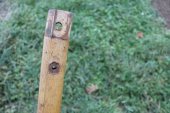Try peening a True Temper and you'll crack it like a mirror! Even for American pattern scythes those puppies are hard. Sometimes GENTLE peening can be used on damaged American pattern blades to correct a wrinkled edge. Tried that on a True Temper Dutch-pattern weed blade and put a nice big spiderweb fracture in the blade. Fortunately it was near the tip so I was able to cut off the broken part and regrind the toe, but it's relegated to "beater" duty now. GREAT blade but don't even try peening out damage! The American scythe is every bit as good of a scythe as the European variety--but it's also a TOTALLY different animal, and as such its care and feeding are different as well, let alone how to properly use it!

As a general rule, if the blade has a narrow tapered tang (English/American pattern tang) then DON'T peen the blade. Stones and files only. For field touchups I like to use a Jewelstik "stubby" diamond steel. Medium grit diamond abrasive on an oval rod. Works great and tucks in your back pocket.










